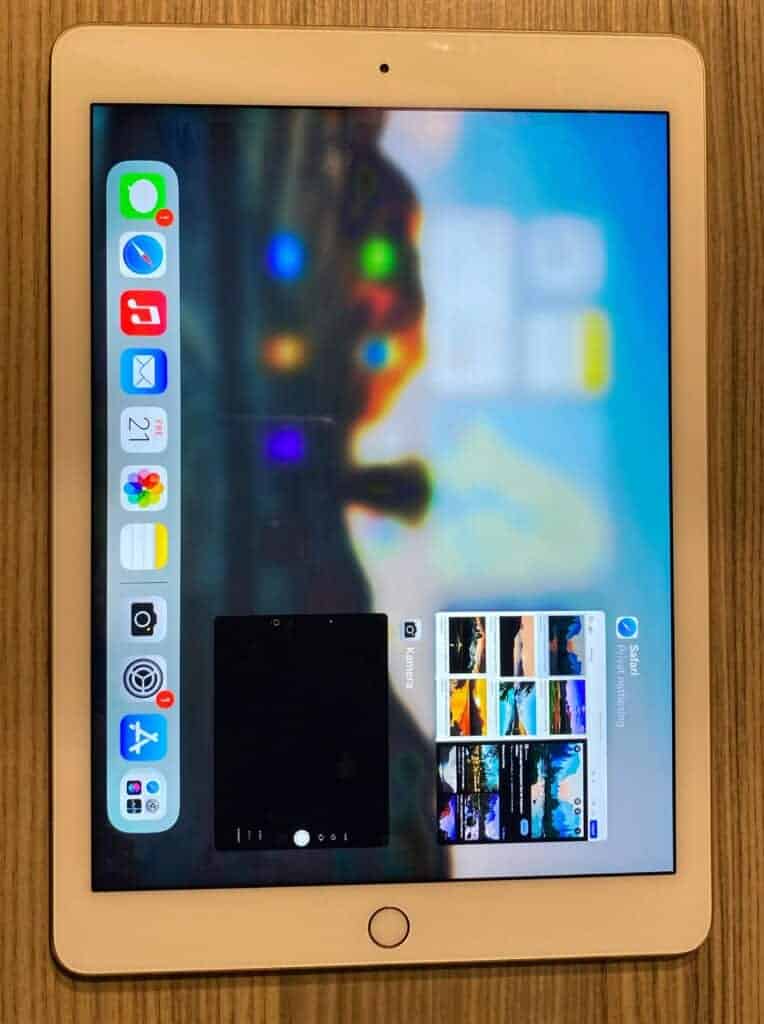If you’ve ever picked up your iPad and noticed that the screen color has changed unexpectedly, you’re not alone. This issue can be caused by various factors, from simple settings adjustments to more complex hardware problems. In this article, we’ll look into the reasons behind this color change and give you practical solutions to restore your iPad’s display to its normal state.
Troubleshooting an Unexpected iPad Screen Hue

Common Causes of Color Changes
An iPad screen suddenly changing color is often alarming, but it’s usually not a sign of permanent damage. Here are some common reasons:
- Software Glitch: A temporary software hiccup can cause the screen to display incorrect colors. A simple restart often fixes this.
- Loose Connections: A jolt or drop might have loosened internal connections. Gently tapping the back of the iPad sometimes helps.
- Temperature Fluctuations: Extreme temperatures can affect the display. Let your iPad return to room temperature before use.
- Magnetized Cases or Accessories: Magnets in cases or accessories can interfere with the screen. Remove them to see if the problem persists.

Less Common, More Serious Issues
Sometimes, a color-changed iPad screen indicates a hardware problem:
- Faulty Display: If the display itself is damaged, you’ll likely need a replacement.
- Water Damage: Liquid exposure can cause all sorts of issues, including screen discoloration.
Troubleshooting Steps
- Restart: Hold down the power button until “slide to power off” appears, then slide to turn off. Wait a few seconds, then turn it back on.
- Remove Case/Accessories: Take off any cases or accessories that might be interfering.
- Adjust Temperature: If your iPad got too hot or cold, let it reach room temperature before using it again.
- Check for Updates: Make sure your iPad is running the latest iOS version.

When to Seek Professional Help
If the problem persists, it’s time to consult an expert.
- Apple Support: Contact Apple Support online or by phone for troubleshooting tips and repair options.
- Apple Store or Authorized Service Provider: Schedule an appointment to have your iPad examined by a technician.
Table: Potential Solutions
| Problem | Solution |
|---|---|
| Software Glitch | Restart your iPad. |
| Loose Connections | Gently tap the back of the iPad. If that doesn’t work, consider a professional repair. |
| Temperature Fluctuations | Let your iPad return to room temperature before using it. |
| Magnetized Case/Accessory | Remove the case or accessory and see if the color returns to normal. |
| Faulty Display | Contact Apple Support or visit an Apple Store/authorized service provider for repair options. |
| Water Damage | Contact Apple Support or visit an Apple Store/authorized service provider for repair options. Avoid using the iPad until it has been professionally assessed. |

Why Your iPad Screen Changed Color
A sudden change in your iPad screen’s color can be alarming, but don’t worry – it’s often caused by a simple setting or software issue. Here’s a table exploring the potential reasons and quick fixes:
| Cause | Color Change | Possible Fix |
|---|---|---|
| Accessibility Settings | Inverted colors, negative hues | – Go to Settings > Accessibility > Display & Text Size. – Check if Invert Colors or Smart Invert are turned on. – Toggle them off if you didn’t activate them intentionally. |
| Night Shift | Warmer, yellowish tinge | – Go to Settings > Display & Brightness. – Check if Night Shift is turned on. – Adjust the Schedule or Color Temperature if needed. |
| True Tone | Dynamic color adjustments based on ambient light | – Go to Settings > Display & Brightness. – Toggle True Tone off and see if the color shift persists. – True Tone might not be calibrated correctly for certain lighting conditions. |
| Software Glitch | Random, inconsistent color changes | – Force restart your iPad. – This varies depending on your model: – iPad with Home button: Press and hold the Sleep/Wake and Home buttons simultaneously for 10 seconds. – iPad without Home button: Press and hold the Volume Up button and Power button for 10 seconds. |
| Hardware Issue | Permanent, localized discoloration | – Contact Apple Support for further assistance. – This could be a damaged display panel or internal hardware problem requiring professional repair. |
Troubleshooting Your iPad’s Screen
Hardware Issues: Beyond the Surface
A color-changed screen isn’t always a simple settings fix. Sometimes, it points to deeper problems within your iPad.
- Water Damage: Even a small splash can wreak havoc on delicate internal components, causing shorts and corrosion that mess with your screen’s colors.
- Impact Damage: A drop, even with a case, can crack the screen or jar loose the connections that send picture signals.
- Manufacturing Defects: Rarely, a screen might have a flaw from the factory that only shows up later.
Remember, your iPad’s screen is more than just glass – it’s a complex system of electronics and delicate wiring.
Safeguard Your Data: Back It Up!
Before handing your iPad over to a repair shop, always back up your data. Repairs, even by professionals, carry a tiny risk of data loss.
Use iCloud, iTunes, or a third-party app to make a copy of your precious photos, documents, and other files. It’s a small step for big peace of mind.
Troubleshooting Made Easy: The Flowchart
Sometimes, fixing your iPad’s screen feels like navigating a maze. This simple flowchart makes it easy:
- Start: Screen color changed?
- Check Settings: Accessibility, Night Shift, True Tone. Fixed? Great! If not…
- Restart: Simple but effective. Fixed? Awesome! If not…
- Remove Case/Accessories: Magnets can be sneaky. Fixed? Yay! If not…
- Hardware Issue? Recent drop, water exposure?
- Yes: Time to call Apple or a trusted repair shop.
- No: Still stumped? Contact Apple Support, they’re the experts.
Beyond Apple: Other Repair Options
While Apple is the official source, sometimes you need a quicker or more affordable fix.
Reputable third-party repair shops exist! Just be sure to check reviews and ask about warranties before handing over your iPad.
iPad Models: Any Quirks to Know?
Certain iPad models might have specific color quirks or known issues. A quick online search for “[your iPad model] screen color problems” can reveal helpful tips or community discussions.
Settings Issues
| Cause | Color Change | Possible Fix |
|---|---|---|
| Accessibility Settings | Inverted colors, negative hues | Settings > Accessibility > Display & Text Size > Toggle off Invert Colors or Smart Invert |
| Night Shift | Warmer, yellowish tinge | Settings > Display & Brightness > Toggle off Night Shift or adjust Schedule/Color Temperature |
| True Tone | Dynamic adjustments based on ambient light | Settings > Display & Brightness > Toggle off True Tone |
| Software Glitch | Random, inconsistent color changes | Force restart your iPad (hold Sleep/Wake + Home or Volume Up + Power) |
| Hardware Issue | Permanent, localized discoloration | Contact Apple Support or a reputable repair shop |
Additional Tips:
- Update your iPad to the latest version of iPadOS to ensure all software is current.
- Check if the color change only occurs in specific apps or situations.
- If none of these solutions work, don’t hesitate to contact Apple Support for expert help.
Identifying the Cause: Settings or Hardware Issue?
The first step in troubleshooting your iPad’s screen color issue is to determine whether the problem is due to your device’s settings or a hardware malfunction. A Reddit user, Distressedmerman, experienced a similar issue where their son’s iPad screen flickered different colors. This could be a clue that the problem might not always be straightforward.
Common Settings to Check
Before delving into more complex solutions, it’s essential to review some basic settings on your iPad that might have been accidentally altered.
Accessibility Features
Your iPad comes with various accessibility features that can alter screen colors. These include:
- Smart Invert: This feature inverts the colors of your display, which can sometimes lead to unexpected color changes.
- Color Filters: Designed for users with color vision deficiencies, this setting can significantly alter the colors on your screen.
Night Shift and True Tone
These features adjust your screen’s color temperature based on the environment. While they’re meant to reduce eye strain, they can sometimes make your screen appear differently colored.
When It’s More Than Just Settings
If adjusting the settings doesn’t resolve the issue, you might be dealing with a hardware problem. As suggested by Felix218_ on Reddit, faulty hardware could be the culprit, especially if the iPad has a history of physical damage, like being dropped in water.
Diagnosing Hardware Issues
Hardware problems can be tricky. If your iPad has been repaired before, as was the case with the Reddit user’s son’s iPad, the issue could be related to a previous repair, such as a disconnected cable or a damaged screen.
Seeking Professional Help
When in doubt, it’s always best to consult with a professional. If your iPad is still under warranty or covered by AppleCare, reach out to Apple Support for assistance.

Preventive Measures and Care
To prevent future issues:
- Use a Protective Case: This can help safeguard your iPad from accidental drops and water damage.
- Regular Maintenance: Keep your iPad clean and check for software updates regularly.
Understanding iPad’s Display Technology
Knowing a bit more about your iPad’s display can also help you understand why these color changes occur. iPads use LCD and, more recently, OLED displays, each with its own characteristics and potential issues.
FAQs
Why has my iPad screen changed color?
Several factors can lead to your iPad screen changing color. It could be a simple settings adjustment like accidentally enabling color filters or Night Shift. A software glitch might also cause temporary color inconsistencies. In some cases, the culprit could be hardware-related, such as a loose connection, water damage, or a faulty display.
How to change iPad screen back to normal color?
Start by checking your iPad’s settings. Ensure color filters, Night Shift, and True Tone are disabled or adjusted to your preference. If the problem persists, try restarting your iPad. If it’s still not resolved, consider if there might be a hardware issue, especially if your iPad has been dropped or exposed to water. In such cases, it’s advisable to contact Apple Support or visit an authorized repair center.
Can software updates cause my iPad screen to change color?
While rare, software updates can sometimes introduce bugs that affect the display. If you noticed the color change after an update, try restarting your iPad or even restoring it to a previous backup if possible.
Should I attempt to repair my iPad myself if I suspect a hardware issue?
Unless you have experience with electronics repair, it’s strongly recommended to avoid attempting DIY fixes on your iPad. Opening up the device can void any warranty and potentially cause further damage. It’s best to leave hardware repairs to professionals.
How can I prevent my iPad screen from changing color unexpectedly?
Keep your iPad software up to date, handle it with care to avoid physical damage, and use a protective case. Also, double-check your settings whenever you notice any unexpected changes to your screen’s appearance.
Are color changes always indicative of a serious problem?
Not necessarily. Color changes can often be resolved with simple settings adjustments or a quick restart. However, persistent or severe discoloration might indicate a hardware problem that requires professional attention.
What should I do if none of the solutions work?
If you’ve exhausted all troubleshooting steps and the problem persists, don’t hesitate to reach out to Apple Support. They have the expertise to diagnose and address complex issues. Remember to back up your data before seeking any professional repair services.







